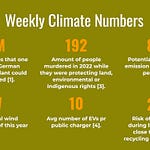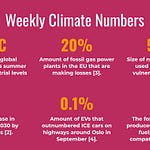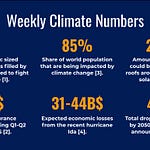Welcome to this weeks edition of The Weekly Climate! 🎉

Credit: ESO/M. Kornmesser
The Visitors (September 13, 2020) — Captains log, time 24572. Arrived at safe distance 0.16AU from the planet 2389AX.C, the third planet from the star 2389AX. We confirm that the planet is located within the goldilocks zone and orbits at a distance of approximately 1 AU from its star. The planet itself looks to be covered largely (~70%) by water, but with large swaths of land. We have confirmed the Chief Scientist’s suspicion that the planet is housing extraterrestrials of some intelligence. Monitoring equipment made out of metal were discovered outside the planet’s atmosphere and we saw signs of what looks like telescopes being pointed directly at our space craft. We don’t know how long they have been monitoring us and we don’t know how much the aliens know so we’re going to maintain our cruising speed and monitor for any signs of hostile activity while we try to assess the intelligence level of the aliens as well as habitability of the planet. Launching space probe now.
Captains log, time 24891. Space probe entered the upper atmosphere of planet 2389AX.C. Monitoring gas levels. 78% Nitrogen, 21% Oxygen, and a surprisingly high levels of carbon dioxide, 0.042%. The carbon dioxide levels indicate, as is also confirmed by the space equipment of the aliens, that they have discovered combustion. Based on the distance from the star, the size of the star, the size of the planet and the amount and composition of gasses in the atmosphere we can calculate an approximate base temperature protection that the planets atmosphere provides. Without atmosphere we calculate the base surface temperature to be -18C. With atmosphere the planet should have a baseline surface temperature of 15C suggesting easily habitable conditions for a water-based life-form.
Captains log, time 24213. The probe has now made a number of orbits and have detected multiple larger cities spread across the entire landmass except the very northern and southern parts featuring only few minor dwellings. Space probe has also detected sub-tropospheric aircraft suggesting that the aliens have invented intercontinental transportation. Judging by the chemical composition of the exhaust the propulsion technology appear to be combustion based. On the night side of the planet the planet lights up as if it is still day suggesting that the aliens have invented advanced light sources and consequently widespread use of electricity. However, lower activity was detected at night like fewer personal transportation vehicles active suggesting that the aliens have an activity period of roughly 16hours followed by a resting period of 8 hours. Large areas of the planet appear to be used for food production.
Captains log, time 24315. A key metric of the intelligence level of the aliens is the composition of the energy sources. As we have seen as a part of our travels combustion based energy sources are typically invented in the earliest era of aliens lifeforms and then switched out once the adverse effects are detected. And here this particular lifeform confuses us. We have only seen very little war-like activity suggesting a maturing intelligence, but we have identified what appears to be a big difference between the level of technology employed in about half of the planets surface compared to the other half. In 50% of the area we detect technology which was modern in our society 500 years ago, like vast communication networks, personal transportation, what appears to be common healthcare facilities, etc, but in the remaining 50% of the habited areas we detect almost no technology. In some cases, not even electricity. However, there are clear evidence that the two very different worlds are connected — as is evident by the sub-tropospheric aircraft, yet why are these areas so underdeveloped? When we then look at their electricity sources we detect vast amounts of carbon dioxide emanating from almost all facilities which appear to be engaged in electricity production, which suggests that the aliens have not moved on from combustion based electricity. In fact, the amount of carbon dioxide and other pollutants emanating from these facilities indicate that the carbon dioxide levels are rapidly rising, which suggests a rapidly increasing average temperature on the planet. This is puzzling as there are clear evidence that they have developed the ability to detect the adverse effect of combustion-based electricity production and we have even seen evidence of adaptations to level 1 climate change effects like sea level increases have been put in place. From our analysis it appears that almost every action that the aliens take are associated with carbon dioxide being emitted. We do see minor indications that the lifeform are employing non-carbon-dioxide electricity production like wind turbines and solar power. We can only wonder why the aliens have not made the transition to cleaner forms of energy sooner as the pollutants emanating from these facilities is likely to cause an increased amount of casualties as well.
Captains log, time 24879. It is time for us to leave. In concluding remarks, the aliens appear to be developing some level of intelligence and the fact that they are working on non-combustion-based electricity sources suggest that they are aware of the predicament they’re in. We suggest to keep on monitoring 2389AX.C. We believe that either the aliens will go near-extinct within the next 2-300 years or they will flourish. At either point it would be wise to make contact. In order to assess the chances of their survival we recommend a spy-mission to identify their mode of government, and other societal structures as well as understanding the big difference between one half and the other half of the alien society and it’s relation to their current climatic predicament.
🏃♂️💨The quick overview
For those in a hurry here we go:
Climate & Science: A new report on the energy imbalance of the Earth is out suggesting we add the same amount of energy to the atmosphere as 400.000 nukes and scientists have found out why the doomsday glacier is melting so fast.
Technology: A new long duration storage technology has been brought to life, which fits perfectly in coal power plants that has been shut down hereby potentially helping to save jobs.
Startups: UK startup begins construction of it’s gravity based energy storage system, Uber pledges all electric fleet by 2030 and Nikola signs deal with GM.
Investing: A group of asset managers totalling 33 trillion € has drawn up a plan to decarbonize their portfolios.
Major emitters: Oil demand is stagnating and Emily Atkin spotlights countless of other wildfires which have not seen much news coverage.
Politics: XRs many demonstrations in UK and lots of coal news among these 7 out if 18 European countries doesn’t plan to phase out coal by 2030.
Climate Justice: Flooding is right now destroying livelihoods in many developing countries, another climate lawsuit against big oil this one by Charleston South Carolina and a report has found that 1.2 billion people will be displaced by climate change in 2050.
🐢The long overview
For those who want to dive deeper, brace yourselves, the long overview is coming.
🕵️♂️Stories we follow
California power outages amidst the heat waves. (Get an overview) California has experienced a series of rolling blackouts Aug 16 through 18 as a result of high power demand and a few mishaps. What we know is that power demand was high, but not higher than usual, when solar started to drop and a fossil gas power plant went unexpectedly offline. The weekend leading into last week was incredibly hot. 49C was measured at one site in Los Angeles, beating all records. California is still battling dozens of blazes, the wildfires having already consumed 2.1 million acres (that’s 10 NYCs!), damaged over 3800 structures and killed 7 people (if you want to see something scary, google ‘orange sky california’ or take a look here or here.. It truly looks like dooms day). To limit fires, the utility PG&E even decided to shut off power to 172.000 customers in California. Clearly, that is not ideal, so many propose solutions such as microgrids which might be the key to keeping the lights on in a new normal that consists of these infernal fire seasons. And it truly has been a crazy week of climate change fueled weather anomalies — the post linked to here describes just 72 hours of weather anomalies from the past week. But as Emily Atkins notes it’s interesting (and very troubling) to see that major news outlets does not attribute these weather anomalies to climate change, despite scientific consensus about the fact.
U.S. Presidential Election. The U.S. is a major emitter and are run by a climate sceptic and fossil fuel friendly… person. We need a change. And after Joe Biden was elected as the democratic candidate that change has to be him. Hence we keep a close watch on his climate aspirations. Biden has laid out a 9 key points of his energy plan, which certainly is more ambitious than Trumps. And if you’re wondering, Trump believes strongly in the fact that he’s the most environmental friendly president since Theodore Roosevelt. I f…ing kid you not. Just in case you haven’t followed his latest attacks on the environment and our climate you should check the last article I linked to — or just any past newsletter. As was kind of expected 15 states are suing Trump for his plan to drill in the Arctic National Wildlife Refuge. Which is a classic problem that presidents who are environmentally friendly face. Also presidents that are responsible human beings would do anything they can to assist in the wildfires that terrorize their population, yet Trump has done nothing to help for the simple reason that the West didn’t vote for him. *sigh* Obama said it clearly in a speech last week: “Vote like your life depends on it — because it does” paraphasing Greta Thunberg who said “I want you to act as if your house is on fire, because it is”.
👩🔬Climate & Science
Karina von Schuckmann et. al (who’s considered the world’s foremost expert on the energy imbalance of the Earth) published a report on the current state of the Earth’s energy imbalance. The energy imbalance represents the amount of heat that are trapped by the Earth’s atmosphere. This energy imbalance has increased to 0.87 W/m2, which doesn’t sound like much, but when it is applied to all of Earth’s surface the amount of energy amounts to 400.000 nuclear bombs exploding every single day.
A scary study has found that as warmer conditions makes trees grow faster (and therefore periodically sequester more CO2 faster) they also die faster which causes them to release the CO2 they’ve sequestered in the form of methane (a 30x more powerful greenhouse gas).
Scientists have discovered that the ‘doomsday glacier’, also known as the Thwaites glacier, is melting so fast because of a series of deep channels beneath it, which acts as pathways for warm ocean water, which leads to accelerated melting of the ice.
A UN report has found that despite global lockdowns due to COVID we’ve hit a new record in atmospheric concentrations of CO2. In fact, what’s more important is that emissions are already back to pre-COVID levels.
🤖Technology
A promising new long duration storage technology has been demonstrated in Australia. The technology is kind of LEGO bricks, but for energy storage. When each brick is heated it stores the energy contained in the heat and when blocks are stacked the energy output available scales with it. Another interesting thing about the technology is that it is perfect to be deployed in shut down coal power plants hereby likely preventing loss of jobs and limits the amount of new infrastructure that needs to be built.
A battery fire in 2019 has spurred energy storage industry action to ensure better fire protection for their products in order to limit the risk to fire fighters. A recent report investigates exactly what went wrong and how the incident in which the ensuing explosion threw one fire fighter 22meters through a chainlink fence.
Staying on batteries, scientists may have cracked the code that leads to ultra fast charging of batteries, which is sure to pave the way for even more EVs on the roads.
💡Startups
A UK startup begins construction of it’s first large scale demonstration of it’s energy storage powered by gravity. The company named Graviticity’s (which clearly must have been thought out by an engineer like myself) technology can be scaled to power between 1 - 20 MW.
Nikola teams up with GM in a 2B$ deal. The deal will give GM 11% of Nikola stock and Nikola will get access to GM’s new battery program and billion dollar fuel cell programme. I think it’s exciting to see big industrial partnerships like this, that utilizes the power of the big established industry to achieve scale.
Uber pledges to have 100% of its fleet converted to electric by 2030. The way they plan to do that is by imposing an extra fee on drivers that drive an ICE car, which will nudge them in the direction of purchasing an EV.
💰Investing
The Institutional Investors Group on Climate Change (IIGCC) is a group of big asset managers (pension funds, investment managers etc) in EU with combined assets totals over 33 trillion €. The IIGCC has drawn up a plan to decarbonize their portfolio and hope that other investors will join them. The group provide assets managers with a set of recommended actions, policies, metrics etc to help facilitate a net zero emission portfolio by 2050.
⛽️Major Carbon Emitters
If people driving SUVs were a country they would be the 7th largest emitter in the world. SUVs emit 0.7Gt or about 1.7% of total CO2 emitted.
Oil demand shows no signs of picking up with jet fuel being the big problem. The International Energy Agency (IEA) downgraded its demand forecast for the year last week.
A UK oil and gas company called Ascent (note the name of this fossil fuel loser company) is suing Slovenia because the Slovenian Environmental Agency has forced the company to perform a environmental impact assessment of a site they plan to exploit using fracking because the site is close to water resources.
I love it how Emily Atkin (yes, we’re fans of her here in Weekly Climate) has a knack for getting the whole picture, and although the world’s media attention is on the wild fires in the U.S. her piece from last week puts a spotlight on the countless of other major wildfires that are happening across the world right now: From Greece to Bulgaria.
On the day this newsletter goes out Better Petroleum (BP) is supposed to present their plan for how to achieve the vision of reducing oil production by 40%. It sure will be exciting to follow.
And we finish off this section with a bang, almost literally, at least fire. A recording that New York Times had gotten access to of a meeting between fossil fuel lobbyist shows that what they say publicly and what is really happening is too very different things. You should really check this one out.
🎩Politics
Extinction Rebellion has staged a number of protests all across the UK two weeks ago. The Guardian reported last week on the many of protests: From meditating outside fossil fuel supporting Barclays Bank to blocking climate sceptic Rupert Murdoch’s newspaper plants.
South Korea will close half of its existing coal fleet (30 plants) by 2034. 10 of these will be shut by 2022. South Korea’s 60 coal plants currently generate 40% of the electricity for the country. Unfortunately, South Korea has also declared that they will shut down all nuclear power plants.
Poland plans to invest 40B$ in new nuclear power plants to help its energy transition. Poland’s grid is currently made up of 78% coal, so that is for sure a welcome addition.
Emily Atkin wrote a detailed piece on how Big Oil’s first publicist advised Nazi Germany. If you want to learn more I can highly recommend the Drilled podcast which goes into this exact theme.
Just to prove how serious climate change related wildfires are a new report has found that the wildfires in the U.S. could spark (in lack of better words) a new financial crisis. The risk is that damages to businesses and homes, might cause people to default and the shear mount of these expected defaults could cause banks to default.
A report has found that 11 out 18 EU countries reviewed does not have a plan to phase out coal by the end of year 2030 — despite the Paris Agreement being pretty clear on that matter. And what’s worse, 7 of these countries stand to receive 21B$ to support their energy transition. There’s clearly something wrong here.
⚖️Climate Justice
Energy Voice published an interesting look at Africa’s options to decarbonize. Which as the author claims, is not going to be easy. Electricity is the way to develop economies and Africa has vast oil and gas resources. Still, we must try our best to help electrify Africa in the cleanest way possible.
Senegal has activated emergency flood aid plan to deal with a major downpour that happened saturday Sep 5. Over a 7hour period the country experienced more rain than they usually get over the entire 3 month rainy season from July to September.
And Sudan experienced similar rainfall and flood when the Nile rose to record of 17.58m. The country have also declared a 3 month state of emergency.
Nigeria’s rice production has also taken a big hit due to flooding. At least 1.2 million acres were destroyed in Kebbi, which is the country’s major rice-growing state. Impact of all the floods mentioned above can be seen in this article.
Charleston, South Carolina, is suing Big Oil for climate change damages related to flooding and especially 2B$ spent protecting the city from rising sea levels. This law suit is just a series of law suits (as reported last week) that aims to hold Big Oil responsible for the propaganda and misinformation it has spread on climate change.
Forbes has announced it’s 30 under 30 list and what these young people are doing about racial injustice, COVID-19 and climate change.
The first ever Ecological Threat Register report shows that 1.2B people could be forced to leave their homes in the next 30 years due to climate change. In addition, the report finds that in the next 20 years, no less than 5.4 billion people will live in countries with extreme water stress.
🎧Podcasts
Drilled — Big Oil’s Bad Bet on Plastic: Amy dives into a Carbon Tracker report that analyzes the demand for plastic. The report reveals that plastic demand is falling, which is contrary to what the fossil fuel industry claims. It is widely known that the fossil fuel industry attempts to use plastic production as a means to survive in a post-fossil fuel world.
My Climate Journey — Ep 121: Bryce Smith, Funder & CEO at LevelTen Strategy: A great episode in which Jason and Bryce discusses many intricacies of working with the electricity grid. Among the most interesting parts of the discussions are the many challenges for renewable energy developers.
How to Save a Planet — Unnatural disasters: Another great episode in which Alex and Ayana dive into the personal stories of people living with these unnatural climate change fueled disasters. They also dive into important factors to consider for people living in the areas and they discuss Ayana’s new book All we can save.
The Interchange — Demand Response and California’s blackouts: Steven and Shayle discusses the role of demand response for california’s blackouts, what role it played and what role it could be play in the future. It’s a very interesting episode that uses the predicament of California as a way to peak into the future of the grid.
Energy gang — Renewables Beat Fossils on Europe’s Grid: The gang discusses a report that says that for the first half of 2020, renewables beat out fossil fuels on the EU grid! This is surely a great milestone, yet almost no countries are on track to meet the Paris agreement still.
That’s it for this week folks! If you feel like I’m missing something, please let me know.
See you all next week 👋











